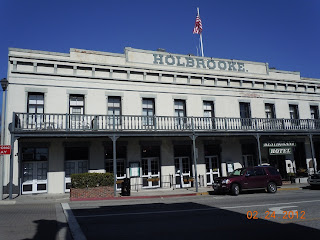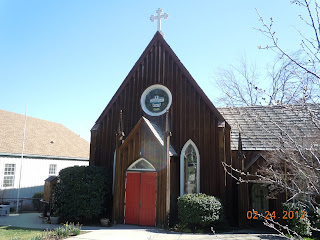 |
| Main Street, Grass Valley California |
The popular story about how gold was first discovered in Grass Valley CA is unique. One account says that a farmer looking for a lost cow turned over a large rock and discovered the yellow metal. It's interesting because I learner that prospectors of the era referred to gold as simply "yellow".
Grass Valley's history is not unlike many of the other gold towns found in the Sierra Nevada foothills. The beginnings were usually as a camp. When gold was discovered, the population of course increased, and not by a small amount, and then the camp evolved into a town. Like several other gold mining towns, Grass Valley CA suffered the destruction of fire. Fire did hit Grass Valley in 1855, after the town grew to a fairly large size, and the result was the destruction of some 300 buildings. Typical of many other gold towns, the buildings were built with wood and fire could spread quite easily. In 1855 the fire fighting resources in a town such as Grass Valley was primitive.
 |
| Hard-rock mining equipment with ore car |
In regards to the Northstar Mine, today Grass Valley tourists can visit the Northstar Mine Powerhouse and Pelton Wheel Museum. The Pelton Wheel on exhibit is said to be the largest one ever constructed. A Pelton Wheel is a water turbine which gathers it's power from moving water. It was invented by Lester Allan Pelton in the 1870's and while there were water wheels before Pelton's invention, his wheel was considered by most as being more efficient. Included in this museum are exhibits of hundreds of Sierra Nevada gold mining artifacts, including a working Stamp Mill and Cornish Pump.
You may know that the first mining that took place in Grass Valley and in many other Sierra Nevada foothill gold towns was placer mining. .This was the easiest, non invasive method. Gold was found on the ground and in stream soil. This was panning for gold. Eventually, the panning gold method decreased and underground hard mining was employed. As the underground mines grew, and this was an entirely different and sometimes dangerous endeavor than placer mining, skilled hard rock miners from Cornwall and Ireland were employed. These skilled immigrants settled in Grass Valley. Mine owners and managers mostly lived in nearby Nevada City, a short drive further north on today's Hwy 49.
One of the things I've enjoyed while visiting the old California Gold Rush towns is visiting their theaters or opera houses. The gold towns that had grown from camps were popular venues for actors and actresses from the era. The close proximity of the Sierra Nevada foothills to San Francisco allowed many performers to add the gold town circuit to their tours. Booming gold mining towns meant that there were plenty of people quite willing and able to spend money on entertainment. Grass valley was no exception and one of it's tourist attractions is the Lotta Crabtree House. Lotta Crabtree was a very popular performer in the 1800's and eventually became quite a big star. History books will tell you she became the very first millionaire entertainer. Today, in San Francisco you can view the Lotta Fountain located at Geary and Market Streets. At her death in 1924, Lotta left an estate of $4 million in a charitable trust. Another popular actor who performed in the California gold camps was Edwin Booth, brother of John Wilkes Booth. Edwin was an actor of great ability and fame but his last name became a burden after the actions of his younger brother in 1865. Eventually he opened his own theater in New York with so-so success.
 |
| Historic Holbrook Hotel, Grass Valley |
Another interesting building in Grass Valley California is the Nevada County Bank which was constructed in 1917 and renovated in 1975. The structure is noted for it's glass dome. The bank was acquired by Bank of America in the 1930's and operated as such until 1975. The building was originally built by the Rector brothers who at the time were also involved in Nevada City California banking enterprises. The bank building is located at 131 Mill Street in downtown Grass Valley.
 |
| Nevada County Bank Building |
Another interesting stop in Grass Valley is the Emmanuel Episcopal Church. The Emmanuel Episcopal Church was established in Grass Valley in 1858 and is the oldest Episcopal church in California. The church is located at 235 South Church Street. Emmanuel's history is intertwined with the miners and pioneers that settled the Grass Valley area during the California Gold Rush.
 |
| Emmanuel Episcopal Church |
The land which this church sits on was donated by the Gold Hill Mining Company and has been conducting services to this very day.
When you drive Hwy 49 and come across the other old gold mining towns you'll find similar sites like this church in Grass Valley. I think it's wonderful that many of these historic structures remain for future generations to explore and many, like the Episcopal Church in Grass Valley still conducts services.There is a Grass valley Museum which is located on the second floor of St. Joseph's Cultural Center. Here you can view clothing and art from the Victorian era. There's also a library, doctor's office, bedroom and a classroom. It's an interesting stop. The address is 410 South Church Street. The museum is operated by the non-profit Historic Mt. St. Mary's Preservation Committee. The building that houses the museum is a brick structure completed in 1866.
Grass Valley California has many buildings on the National Register of Historic Places and it's a terrific fun and educational vacation or short trip destination. Grass Valley is located about 57 miles east of Sacramento via Interstate 80 and Hwy 49. The easy and scenic drive takes a little over one hour.
(Photos are from author's private collection)

